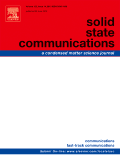
SOLID STATE COMMUNICATIONS
Scope & Guideline
Disseminating Pioneering Findings in Materials Chemistry
Introduction
Aims and Scopes
- Optoelectronic Properties:
Research on the electronic and optical characteristics of materials, particularly in relation to their applications in devices such as solar cells, LEDs, and photodetectors. - Thermoelectric Materials:
Investigations into materials that can convert temperature differences into electric voltage, including studies on their thermoelectric efficiency and applications. - Magnetic Properties and Spintronics:
Exploration of magnetic materials and their properties, with a particular focus on applications in spintronics and related technologies. - First-Principles Calculations:
Utilization of density functional theory (DFT) and other computational methods to predict and analyze the structural, electronic, and mechanical properties of materials. - Nanostructured Materials:
Studies on the synthesis, characterization, and applications of nanomaterials, including their unique properties and potential uses in various fields. - Phase Transitions and Structural Changes:
Research focused on understanding the phase behavior of materials under different conditions, including high pressure and temperature. - Doping and Defects:
Investigations into the effects of doping and defects on the properties of materials, which can significantly influence their performance in applications. - Multiferroic and Ferroelectric Materials:
Studies aimed at understanding and improving materials that exhibit both ferroelectric and magnetic properties, with potential applications in memory devices and sensors.
Trending and Emerging
- Lead-Free Perovskites:
Research on lead-free halide perovskites is gaining momentum due to their environmentally friendly nature and potential applications in optoelectronics and photovoltaics. - 2D Materials and Heterostructures:
The study of two-dimensional materials, such as graphene and transition metal dichalcogenides, and their heterostructures is rapidly expanding, driven by their unique electronic, optical, and mechanical properties. - Quantum Materials and Topological Phases:
There is a growing interest in quantum materials and topological phases, which hold promise for novel electronic and spintronic applications. - Machine Learning in Materials Science:
The integration of machine learning techniques in materials science research is on the rise, facilitating the discovery and optimization of new materials. - Sustainable and Green Technologies:
Research aimed at developing sustainable materials and processes, including energy-efficient and environmentally friendly technologies, is increasingly emphasized. - Magnetocaloric Materials:
The exploration of magnetocaloric materials is trending, particularly for applications in magnetic refrigeration, which is seen as a more energy-efficient cooling technology.
Declining or Waning
- Traditional Superconductors:
Research on conventional superconductors has seen a decline as interest shifts towards high-temperature and unconventional superconductors, which are perceived to have more significant technological implications. - Bulk Materials Studies:
There is a waning focus on bulk material properties, as research increasingly emphasizes nanostructured and thin-film materials due to their unique properties and applications in modern technology. - Conventional Photovoltaic Materials:
Traditional silicon-based photovoltaic research is experiencing a decrease in focus as new materials, such as perovskites and organic photovoltaics, gain prominence due to their potential for higher efficiency and lower production costs. - Classical Magnetic Materials:
Studies on classical magnetic materials are diminishing as researchers explore more advanced materials with complex magnetic properties and novel applications in spintronics.
Similar Journals

PHYSICA STATUS SOLIDI B-BASIC SOLID STATE PHYSICS
Connecting Researchers Through Groundbreaking Physics InsightsPHYSICA STATUS SOLIDI B-BASIC SOLID STATE PHYSICS, published by Wiley-VCH Verlag GmbH in Germany, is an esteemed journal within the condensed matter physics sphere, covering pivotal advancements in basic solid state physics. With a rich history dating back to 1961, it serves as a scholarly platform for researchers, professionals, and students alike, providing insights into the fundamental properties and applications of electronic, optical, and magnetic materials. The journal currently holds a respectable Q3 ranking in both Condensed Matter Physics and Electronic, Optical, and Magnetic Materials as of 2023, indicating its impactful contributions to these fields despite its competitive landscape. While it does not offer open access, its comprehensive research findings are critical for those engaged in innovative material science research. With a convergence period extending to 2024, PHYSICA STATUS SOLIDI B continues to play a significant role in facilitating knowledge exchange and fostering advancements in solid state physics.

SOLID STATE SCIENCES
Advancing the Frontiers of Materials ResearchSOLID STATE SCIENCES is an influential academic journal published by Elsevier, focusing on advancements in the fields of chemistry, condensed matter physics, and materials science. With an ISSN of 1293-2558 and an E-ISSN of 1873-3085, this journal has been at the forefront of disseminating innovative research since its inception in 1999 and is projected to continue until 2024. Positioned in the prestigious Q2 category in multiple disciplines for 2023, SOLID STATE SCIENCES ranks #87 in condensed matter physics, #101 in general chemistry, and #124 in general materials science within Scopus. Researchers and professionals in these fields will find this journal indispensable, offering open access options that enhance global visibility and accessibility of cutting-edge research, fostering collaboration and innovation. With its commitment to showcasing substantial contributions and novel methodologies, SOLID STATE SCIENCES plays a vital role in shaping the future of materials research.
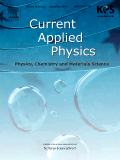
CURRENT APPLIED PHYSICS
Exploring Innovations in Physics and Materials Science.Current Applied Physics is a leading journal published by Elsevier, specializing in the dynamic fields of Physics and Materials Science. With an ISSN of 1567-1739 and an E-ISSN of 1878-1675, this journal focuses on the latest advancements and applications of physics principles in various practical domains. Operating from the innovative hub of Amsterdam, Netherlands, Current Applied Physics occupies a significant niche in the scientific community, evidenced by its Q2 ranking in both the Physics and Astronomy and Materials Science categories for the year 2023, along with impressive Scopus rankings that highlight its relevance in the fields of General Physics and General Materials Science. The journal's scope encompasses a wide range of topics, fostering interdisciplinary collaboration and facilitating the exchange of knowledge among researchers, professionals, and students. Each issue features peer-reviewed articles that contribute to the understanding and application of physical sciences, making it an essential resource for those aiming to stay at the forefront of research and innovation in applied physics.

Journal of Advanced Dielectrics
Innovating the Future of Dielectrics and CompositesThe Journal of Advanced Dielectrics, published by World Scientific Publishing Co Pte Ltd, is a pivotal open-access platform since 2014 dedicated to advancing research in the fields of dielectrics, ceramics, and composites. Based in Singapore, this journal aims to bridge the gap between theoretical developments and practical applications in Electrical and Electronic Engineering, Condensed Matter Physics, and Electronic, Optical, and Magnetic Materials. With an impressive classification in the 2023 Quartile Rankings indicating its significance within its categories, and notable Scopus Rankings that highlight its impact and relevance, this journal serves as a vital resource for scholars and professionals committed to cutting-edge research and innovation. As it continues to flourish through the converging years from 2015 to 2024, the Journal of Advanced Dielectrics stands as an essential conduit for the dissemination of knowledge in advanced material sciences, making it an indispensable asset for today's research community.

PHYSICS OF THE SOLID STATE
Connecting Academia and Industry through Rigorous ResearchPhysics of the Solid State is a distinguished journal published by Pleiades Publishing Inc., focusing on the rapid advancements and fundamental research in the realms of condensed matter physics, electronic, optical, and magnetic materials. With an ISSN of 1063-7834 and an E-ISSN of 1090-6460, this journal serves as a crucial platform for disseminating high-quality research findings, insights, and reviews essential for both academic and industrial professionals in the field. As of 2023, its Scopus ranking places it in the 26th percentile for both Condensed Matter Physics and Electronic, Optical and Magnetic Materials, reflecting its evolving influence and contribution to the scientific community. Although currently classified in the Q4 quartile, the journal aims to foster interdisciplinary dialogue, improve research visibility, and enhance its impact on contemporary scientific challenges through rigorous peer-reviewed articles and focused special issues. Despite its traditional model of access, it continues to play a pivotal role in engaging researchers and fostering innovation in solid-state physics.

Frontiers of Physics
Connecting Ideas, Inspiring Physics ExcellenceFrontiers of Physics, published by Higher Education Press, is a premier open-access journal dedicated to fostering innovative research and excellence within the field of physics. With an ISSN of 2095-0462 and an E-ISSN of 2095-0470, this rapidly growing journal has established itself as a valuable platform for disseminating cutting-edge findings, covering a diverse range of topics from theoretical frameworks to experimental advancements. Notably, Frontiers of Physics has achieved an impressive Q1 ranking in the 2023 Scopus Quartiles for Physics and Astronomy, securing a competitive 5th out of 81 positions in its category, reflecting a high impact factor that underscores its importance to the scientific community. Since its inception in 2011 and continuing through 2024, the journal aims to bridge the gap between academia and industry, encouraging collaboration among researchers, professionals, and students alike. Its commitment to open access ensures that high-quality research is readily accessible, thereby promoting knowledge sharing and advancement in the global physics community. Explore the potential of your research in Frontiers of Physics, where the future of physics flourishes.
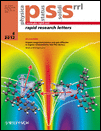
Physica Status Solidi-Rapid Research Letters
Fostering Rapid Advancements in Materials SciencePhysica Status Solidi-Rapid Research Letters is a distinguished peer-reviewed journal published by WILEY-V C H VERLAG GMBH that serves as a critical platform for the rapid dissemination of research in the domains of Condensed Matter Physics and Materials Science. Since its inception in 2007, the journal has maintained an impressive Q2 ranking in both relevant categories, underscoring its significant impact within the scientific community. With an E-ISSN of 1862-6270, it offers insightful contributions to the understanding of advanced materials and their applications, attracting a global audience of researchers, professionals, and students. Although not an open-access journal, it is recognized for its rigorous review process and high-quality publications that push the boundaries of knowledge. By encouraging the exchange of innovative ideas and findings, Physica Status Solidi-Rapid Research Letters continues to solidify its role as an essential resource in fostering scientific advancements.
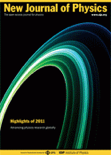
NEW JOURNAL OF PHYSICS
Shaping the future of physics through collaboration.NEW JOURNAL OF PHYSICS, published by IOP Publishing Ltd, is a prestigious open-access journal that has been at the forefront of the physics community since its inception in 1998. With an impact factor that places it in the Q1 category of Physics and Astronomy (miscellaneous) and a commendable ranking of #49 out of 243 in the general physics and astronomy category according to Scopus, this journal is recognized for its significant contribution to advancing research in the field. The journal caters to a broad scope of topics, providing a platform for the dissemination of cutting-edge research findings and innovative theoretical explorations. Operating from the United Kingdom, it offers a truly international perspective, making its contents accessible and impactful to a global audience. With robust open-access options, the NEW JOURNAL OF PHYSICS ensures that research findings are freely available, promoting collaboration and knowledge sharing among researchers, professionals, and students alike. This commitment to accessibility, combined with its high-quality content, makes it an essential resource for anyone engaged in the physics community.
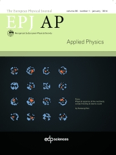
EUROPEAN PHYSICAL JOURNAL-APPLIED PHYSICS
Transforming Ideas into Impactful ResearchEUROPEAN PHYSICAL JOURNAL-APPLIED PHYSICS, published by EDP SCIENCES S A in France, serves as a vital platform for the dissemination of cutting-edge research in the fields of condensed matter physics, electronic, optical and magnetic materials, and instrumentation. With an ISSN of 1286-0042 and E-ISSN of 1286-0050, this journal has been a valuable resource for researchers since its inception in 1998, aiming to foster innovation and dialogue among professionals and academics alike. Featuring an impact factor that reflects its growing influence, the journal is currently ranked in the Q4 quartile for several related categories in 2023, underscoring its ongoing contributions to the scientific community despite its relatively competitive positioning. Access to the journal is available through various Open Access options, ensuring that pioneering research is readily accessible to all. As it continues to evolve towards its 2024 objectives, EUROPEAN PHYSICAL JOURNAL-APPLIED PHYSICS remains dedicated to advancing knowledge and facilitating collaboration in applied physics, making it an essential resource for students, researchers, and professionals dedicated to exploring the forefront of physical sciences.

Crystals
Exploring the Boundaries of Crystalline InnovationCrystals is a premier open-access journal, published by MDPI since 2011, that focuses on the multidisciplinary fields of chemical engineering, condensed matter physics, inorganic chemistry, and materials science. With its E-ISSN 2073-4352, the journal is headquartered in Switzerland, and actively contributes to the global scientific community by facilitating the dissemination of high-quality research. Ranking in the Q2 quartile across multiple categories, including Chemical Engineering (miscellaneous) and Materials Science (miscellaneous) for 2023, Crystals provides a platform for innovative studies that span from fundamental research to practical applications. The journal's commitment to open access ensures that groundbreaking findings are readily available to researchers, professionals, and students alike, fostering an environment of collaboration and knowledge sharing that is essential in advancing the scientific understanding of crystalline materials.